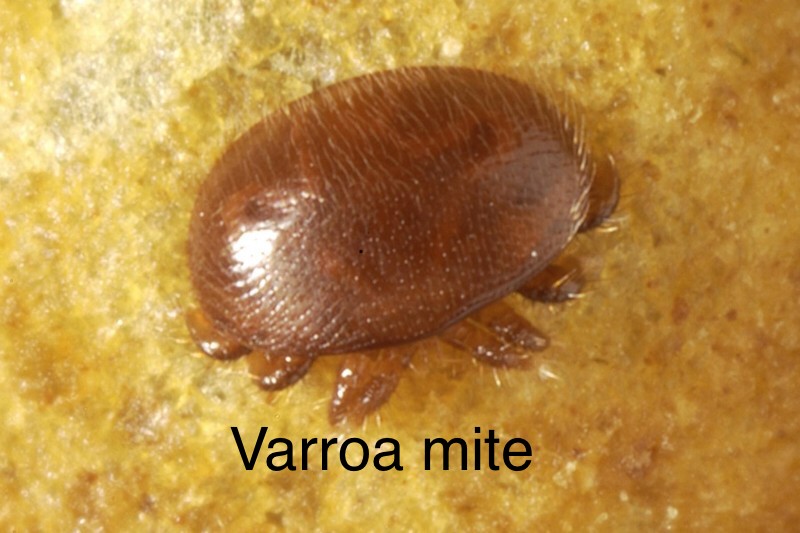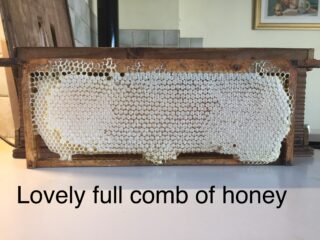
So Summer has finally arrived – it took long enough! The past two weeks have been fantastic for the bees, giving them a second flow of nectar to boost their diminishing reserves. Mind you, during the previous weeks of gloomy skies and mizzle the bees were getting desperate for stores, in particular nuclei. I noticed one of mine was not flying and there were a few dead bees on the ground outside the entrance. When I looked inside I could see dead bees on the floor and a tight cluster of bees on two combs. Looking at each in detail I saw there were no honey stores and the larvae were dying though I spotted the queen, marked white, so that was a positive. I did my usual spraying with sugar syrup and sprayed it into the empty combs as reserves. Within minutes they appeared back to normal and were flying like the other colonies, though not excessively because of the gloomy weather.
Another colony, a swarm which I had augmented with bees from yet another swarm by hiving them in a super, removing the queen and placing that super above the first swarm over a queen excluder, was not flying and though there was a feeder on the hive they were not taking the food down. They had been like this for about a month, so I decided the time had come to put all the bees in the one box with the feeder on top of that. Immediately, they started to take the feed – don’t ask me why or what had changed their minds about feeding – but it worked!
I said last month that the swarming season was over. Well, it finally is – except that I was asked at the beginning of the month to remove a swarm from a traffic cone!!
 Problem was it had been there so long it was now a viable colony with comb, so not an easy process to remove. I therefore brought the cone home and placed it in my apiary as it was, though I still haven’t found the time to transfer the bees and comb from the cone to a brood box with frames, so they might have to over-winter like that.
Problem was it had been there so long it was now a viable colony with comb, so not an easy process to remove. I therefore brought the cone home and placed it in my apiary as it was, though I still haven’t found the time to transfer the bees and comb from the cone to a brood box with frames, so they might have to over-winter like that.
Now the summer weather has returned, I have at last been able to think about removing honey supers from my hives. I normally do this at the end of July but here we are nearly at the end of August. I know everything is about a month later than usual in nature this year, but there were two other reasons for this delay. Firstly, I knew that with the awful “summer” weather we’d been experiencing that the bees were going to be desperate for food and would need what little extra was in their supers to keep them alive – my bees are worth more to me than a honey harvest. Secondly, once the main flow has stopped, the bees become very protective of their stores which can make honey removal a mighty battle, which the bees can often win!! So, once we’d had a week to ten days of hot weather and it was obvious that the bees were foraging on “something”, I went to the first hive to remove a super. The bees were as placid as anything, as they have been in all my hives so far (I still haven’t finished!). As I suspected, the bees had started to eat there way through the first supers of stored honey on their hives, so their lives had been saved by my delay.
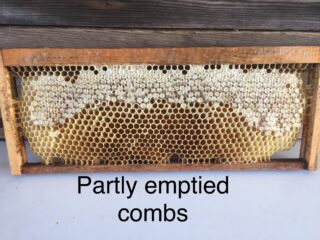 The present flow should sustain them until the ivy starts to flower, hopefully.
The present flow should sustain them until the ivy starts to flower, hopefully.
The supers above the first one, however, were a lot fuller and so far have yielded a very good crop. Considering the weather we’ve had this year, I am both surprised and delighted at the honey crop I am extracting, so I am what you might call “a happy bunny”.
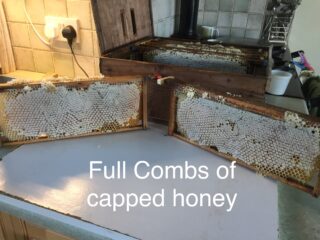
Of course, those colonies that were late swarming did not have as much honey as the early swarmers, as the latter had time to recoup and expand their colonies with newly-laid brood which hatched and developed in time for the flow, but considering what a swarmy season it has been the bees have done me proud!
Many people ask me why I let my bees swarm and why do I collect swarms like I do. One reason for the latter you already know – a swarm in my possession will not end up in someone’s roof space or chimney, which I then get called to remove. The reason for the former is that it is the natural instinct of the bees to swarm, to propagate the species. Also, to prevent them swarming (or rather, to thwart their efforts by performing an artificial swarm on them), I would need to open up the hive and check the brood box for swarm cells every seven days. I used to do this in my early beekeeping days, when I was learning the craft, but such intervention is highly disruptive to the colonies concerned. It takes anything from 48 to 72 hours for a colony to get back to where it was before the intervention in terms of replacing honey sucked up as a result of the bees fearing they might have to abandon their home, and in terms of the hive temperature and humidity required for the raising of brood. Brood has to be maintained at a temperature of 35ºC and a humidity of between 50-60%. Once the hive is opened all this is lost and has to be re-established – not a rapid process.
Additionally, swarming dramatically interrupts the life cycle of the Varroa mite because, once the old queen has left the hive with the swarm, no new eggs are laid until the newly hatched queen has emerged and gone on her mating flights and returns to the hive to start laying. This can be a matter of about five or six weeks and as a result of this absence of new eggs, the number of hatching larvae also reduces and it is inside the larval cells that Varroa mites themselves propagate.
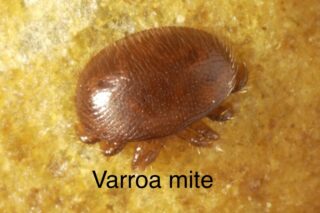 This keeps mite levels low and at a level which the bees can learn to manage. This is why I do not have a need to use chemicals in my hives to control Varroa – the bees do it for me. We will never get rid of Varroa if we rely solely on chemical treatments. We have to create an environment conducive to the bees finding their own remedies and hopefully I am helping them find these remedies by allowing them to swarm.
This keeps mite levels low and at a level which the bees can learn to manage. This is why I do not have a need to use chemicals in my hives to control Varroa – the bees do it for me. We will never get rid of Varroa if we rely solely on chemical treatments. We have to create an environment conducive to the bees finding their own remedies and hopefully I am helping them find these remedies by allowing them to swarm.
So, I’ve removed the honey supers – what next? The first thing to do is to take each honey comb and remove the wax cappings that the bees have used to seal the honey cells to prevent honey spoilage. I do this with a serrated bread knife, collecting the cappings and attached honey in a stainless steel tray underneath which are subsequently melted when the wax can be separated from the honey.
Once both sides of a comb have been de-capped, the comb slots into a cage inside a stainless steel honey extractor. Once all the slots in the cage are full, the cage is spun to throw all the honey out of the combs onto the side of the extractor, from where it slides down to the bottom. Once all the frames from the super are extracted, a tap at the bottom of the extractor is opened and the honey fed through a coarse strainer (to remove bits of wax from the broken cells) into a large, sealable honey bucket. It is then stored to allow it to continue maturing under the influence of the enzymes added to it by the bees. Some people bottle their honey straight from the extractor tank but I feel it is better to allow it to mature totally before eating – and honey bottled at these two points does taste different!
Perhaps next time I will show you the extractor at work and the storage process, but enough for now. I want to tell you about Asian Hornet week, 6-12 September. The British Beekeeping Association (BBKA) is asking everyone to be vigilant in looking out for this exotic pest, Vespa velutina. If it became established in the UK it could decimate our pollinators, as it is doing in France and the Channel Islands. While Spring is the time for capturing Asian Hornet queens, Autumn is the time for trapping the workers, as wasps and hornets lose their sources of floral nectar, making bee hives full of honey very attractive pickings for them. During Asian Hornet week the BBKA will be making multiple resources available on its website (bbka.org.uk) including news, information, pictures, video clips and lectures. As ever, it is important that we all (especially beekeepers) keep our eyes peeled for sightings of the insect or its nest, which being the secondary nest, is likely to be high up in the branches and leaves of trees. If you suspect you’ve spotted an Asian Hornet (yellow legs, single yellow band on a black abdomen, reddish coloured head), take a photo (they’re generally quite amenable to being photographed if you don’t shake or vibrate what they’re sitting on, though be careful) and send it to alertnonnative@ceh.ac.uk, or set up some Asian Hornet traps (plans can be found on the internet utilising a used lemonade bottle).

Enjoy the balmy weather in the weeks ahead.
Colin Rees 01872 501313 07939 971104 colinbeeman@aol.com

